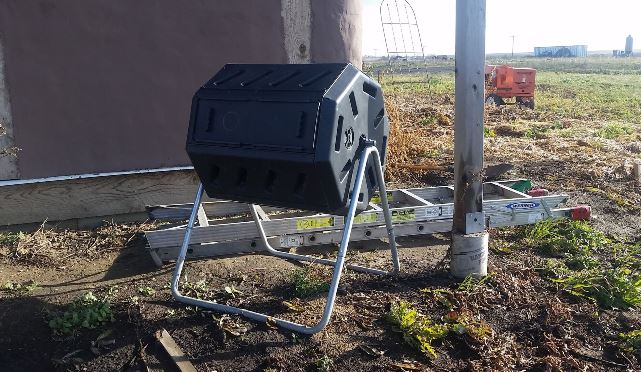
Tumbling compost bins
courtesy of the Saskatchewan Waste Reduction Council
Bins are a tidy way to compost outdoors. They keep materials compact and help maintain the damp, warm conditions needed for decomposition. Tumbling bins are completely enclosed and spin on an axle. There are many tumbling compost bin styles available, some of which are compact enough for small spaces such as balconies.
Using a tumbling composter
- Start by siting the bin. Ideally it should be in partial shade, but bins can also go in full sun or full shade if necessary. Try to put the bin somewhere that it is convenient to use.
- Add green material* (kitchen waste, green plants, or grass clippings) as it is available.
- Balance each addition of green material* with a slightly larger amount of brown material** (dead leaves, dead plants, woodchips, or shredded paper products) at the same time. It is useful to keep one or two bags of dead leaves around for this purpose throughout the year.
- If possible, add a small scoop of soil or finished compost after adding greens and browns.
- Add enough water to dampen the compost all the way through.
- To maintain: Keep the compost damp by adding water when necessary. Stir the compost by turning the tumbler every week or so.
Depending on particle size and specific materials used, some compost should be finished after 3-6 months. However because tumbling bins mix all the newer and older materials together, it can be difficult to get pure finished compost from a tumbler unless they have two separate compartments to use. Otherwise it may be necessary to have two tumblers or one tumbler and another compost system, so that the tumbler's contents can finish processing while fresh materials are going into a different batch.
Finished compost is dark brown and crumbly, and has a damp earth smell rather than a sour smell. It may still have bits of unprocessed brown material present; this can either be ignored or sieved out with wire mesh. Finished compost can be dug into soil, used as a top-dressing, raked onto a lawn, or used in a potting mix blend.
What composting style do they fit?
Tumbling compost bins typically have a small capacity and easily can run out of room if they are not kept quickly processing, so they work best for hands-on composters that are willing to manage them closely. They work best for hands-on composters with mainly kitchen waste or very small amounts of yard waste.
What space does it need?
Tumbling compost bins need an outdoor space. They can be used in a yard, on a patio, or on a balcony. They work best in partial shade but can be placed in full shade or full sun if necessary.
How do they work?
Tumbling compost bins are a form of aerated composting which relies on naturally-present decomposition microbes to digest organic waste and turn it into finished compost. These microbes require 5 things to function properly:
- Green material* (this should be about 40% of the mix)
- Brown material** (this should be about 60% of the mix)
- Moisture
- Oxygen (air)
- A small amount of soil or finished compost
*Green materials are nitrogen-rich, fresh stuff such as green plants, grass clippings, and kitchen waste. Kitchen waste here includes vegetables and fruits, tea bags, coffee grounds and filters, egg shells, and grain-based products but excludes meat, bones, dairy, and grease.
**Brown materials are carbon-rich, weathered stuff such as dead leaves, dead plants, sticks, woodchips, and shredded paper products.
If the compost doesn't seem to be breaking down, check that it is still damp all the way through. Add water if necessary. If it is damp and still not breaking down, consider adding additional green materials* to the mix.
If the compost has a putrid smell, fluff it to add air and stir in additional brown materials.** Small amounts of soil can also be added.
Can you use it all year?
Tumbling compost bins can be used in spring, summer, and fall. In winter the contents will freeze, preventing tumbling, and the lid may also freeze shut.
There are two main options to continue diverting organic waste during the winter months. The first option is to place kitchen waste into paper bags or sheets of newspaper and store frozen outside until spring, when they can be added into the tumbler. Alternatively, consider adopting an indoor composting method during the winter such as bokashi buckets, vermicomposting, or compost tubs.
Not sure what model to buy?
When selecting a tumbling compost bin, sturdiness, aeration and ease of use are important. Door design is likely the most inconsistent between models. Look for a door that can open fully without being damaged when emptying the bin and that is functional in all seasons, even if it's dirty or if you're wearing mitts.
For an overview of tested models, please see the SWRC's Dishing the Dirt report. Note these was tested in 2014 so models may have changed. Compost bins are not terribly complex so the overall function dicussion issues will be useful in your decision making when evaluating current bins. 2014 models tested include:

